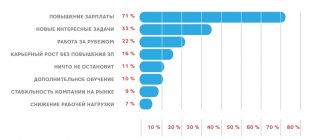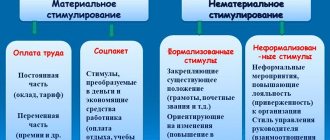External and internal motivation – where to look for the need for development?
Life goes, but where? A person goes through life in a certain direction, and this direction is different from ordinary survival. There is an animal in everyone, driven by instinct. There are motor muscles, a nervous system that provides movement. Motivation helps to make a person’s actions meaningful, and to make him humanized and intelligent, interacting with his own kind.
This is movement from point A to B with a specific goal. Point B may be desirable because it is prestigious. You need to get to point B according to your inner command - “I can!” One point - two motives. Therefore, we should talk about the types of motivation and the sources of their occurrence.
What is motivation
Psychology views motivation from the perspective of a need for something. Need, the feeling of discomfort associated with it, depends entirely on the situation - environment, mood. The state of “yesterday I wanted to, but today I don’t really want to” hardly motivates action.
Motivation is the thought of how good it would be if. In fact, it's a dream, but not every dream motivates you to get off the couch. This is the dream that makes her achieve it. Turns a person into a scientist who has created a hypothesis of his own satisfaction if certain conditions are achieved.
Any real scientist begins to think through a plan of action, conduct experiments, and move towards the goal step by step.
The starting point in motivation becomes internal discomfort, the discrepancy between the real and the desired. Motivation is what forces two factors to be correlated:
- I can or I can’t (opportunities);
- I want or don’t want (intentions).
A person’s capabilities depend on abilities, equipment and knowledge - competencies. This is how motivation can stimulate the internal development of abilities, learning, to lead to a goal. However, the absence of one of the elements will lead to the fact that volitional effort will not be formed, and lack of will will lead to disappointment and stress.
Motivation in international activities
For managers engaged in international activities, the availability and development of competencies is important. They refer to a person's ability to use observations and logical inferences in order to understand various situations and gestures that arise, as well as to respond appropriately to them. The competency structure includes three key elements that are in constant interaction:
- cognitive;
- emotional;
- physical.
The essence of the cognitive component is mutual understanding and learning ability. The emotional component consists of self-motivation, as well as a feeling of self-confidence and strength, the desire not to give in to difficulties that arise and to work even harder to overcome them and achieve better results. The physical element is reflected in the ability to change speech and body language. Understanding and effective use of the three component competencies is impossible without the presence of harmonious coexistence of the body, head, and heart. A highly competent leader is able to perceive and implement new ideas, methods, and approaches. Thus, managers working in an international market adapt to new conditions more easily and quickly in cases where they have the ability to understand people other than themselves, put themselves in their place, and cooperate with them. The existence of a unified concept of motivation and the application of the same motivational theories developed by prominent foreign researchers does not make the labor motivation systems in Russia and other countries the same. There are a lot of striking differences. The most successful in terms of stimulating workers are Japan and the USA. The shortcomings of the domestic motivation system should be determined by studying foreign practical experience.
Main characteristics
Motivation consists of two parts:
- a person’s internal psychological attitude towards action or inaction;
- the ability to effectively correlate opportunities and abilities to achieve a goal.
It comes to a person in the form of specific experiences that are associated with positive emotions from achieving an object or realizing an idea. But the motive is realized only when it coincides with the ideals and cultural values of a person and society at a given moment in time.
The motif has several characteristics:
- gives energy for activity;
- directs actions to achieve goals;
- causes selectivity of attention;
- prepares for typical reaction scenarios.
The motive also necessarily includes the activity itself to achieve the goal. Motivation is not only how much a person wants to achieve a goal, but how much effort he is willing to put into it.
List of used literature
- Bazarova, T.Yu. Personnel management / T.Yu. Bazarova. – M.: UNITY, 2006. – 107 p.
- Control Theory: Textbook / Ed. Ed. A.L. Gaponenko, A.P. Pankrukhina. – M.: Publishing house RAGS, 2005. – 558 pp., 3000 copies. (In lane)
- Don’t repeat mistakes: (Advice to the manager) / Comp. I. V. Lipsits. – M.: Economics, – 2006.- 312 p.
- Vikhansky O.S., Naumov A.I. Workshop on the course “Management”. – M.: Gordarika, 2007.
- Personnel management /ed. V.A. Spivak 2007
- Pugachev V.P. Organizational personnel management: Textbook. – M.: Aspect Press, 2008. – 279 p. – (Series “Human Resources Management”).
- Gerchikova I.N. Management: Textbook for universities - 4th ed., revised. And additional – M.: UNITY-DANA, 2007. – 511 p. – (Series “Golden Fund of Russian Textbooks.”)
- Starobinsky E.E. How to manage personnel. - M, 2007
- Mikhaleva E.P. Management: lecture notes. – M.: Yurayt-Izdat, 2007.- 175 p.
- Burlakov G.R. Motivational climate of the organization - M.: INFRA-M., 2002.,
- Global Internet
- Master of Business Administration (Adoption Management)
- Abstract: Alfresco
- How to get into a working mood. Review of effective self-motivation techniques
- How to get into a working mood. Review of effective self-motivation techniques (How to get started in the morning)
- Determinants of behavior in different cultures (The concept of “personality determinants”)
- How can technology improve our learning process? (In the discipline “Practical course of the first foreign language”).
- TRICHOMONIASIS
- Abstract (Galileo's principle of relativity)
- Features of leader etiquette
- TYPES OF BEHAVIOR OF EMPLOYEES IN A CONFLICT SITUATION. CONFLICT RESOLUTION ALGORITHMS
- Structural divisions of the organization. Definition. Functions. Leadership (Sports Management)
- Structural divisions of the organization. Definition. Functions. Management (Faculty of Sports Management).
Types of motivation
A person goes towards something or leaves something.
In the first case, it is a positive motivation - movement “towards a goal”, in the second - negative - “from dissatisfaction (fear/poverty/poor self-esteem). But usually positive and negative motives are combined: if I quit smoking, I will become healthier, I will be able to play sports and earn more. “I’ll quit” in the context of a smoker is a negative attitude, but the ultimate goal is positive. Motivation makes you become better! External motivation is a call to action that can bring money, approval, or promotion. Doing something interesting for satisfaction and self-realization is internal motivation. External - can be determined by a motive from within - a view of the situation, the internal state of a person. As a result, external and internal motivation have blurred boundaries. Motive is what affects a person’s consciousness and depends on his picture of the world. Therefore, the need for movement necessarily includes characteristics of internal and external motives: by taking action, a person changes the world around him and his attitude towards it.
“Intrinsic motivation” is a term that was introduced by R. Woodworth: a person is born with the goal of mastering the world through behavior - effective interaction with surrounding objects. Other types of internal motivation are considered by R. White, such as the search for a “sense of effectiveness,” when a person acts for the sake of the need for efficiency, competence and mastery.
Classification of motivation by other factors
In psychology, people are divided depending on their motivation to succeed or the desire to avoid failure, which is determined by developed tests. However, people who are motivated to succeed, in case of failure, look for those to blame. People who strive to avoid failures, on the contrary, look for the cause of failure within themselves, therefore they are always ready to find reserves to increase the efficiency of their activities.
Procedural direction
This includes the so-called theory of expectations, developed by V. Vroom. According to it, motivation can be represented as a combination of the expected result of work, the planned reward and the degree of value of the activity.
Another theory is Atkinson's theory of justice. According to it, motivation is subjective in nature when employees compare their own reward with the reward for other people engaged in similar activities. By comparing his own and someone else's remuneration, a person assesses the fairness of this, which, as a result, affects the efficiency and quality of subsequent work.
There is also a combined version of the motivational theory based on the component theories of justice and expectations (authors: L. Porter and E. Lawler). Here, the degree of effort put into work depends on the size (value) of the reward, as well as the feeling of confidence in a fair reward for the work performed.
Extrinsic versus intrinsic motivation: which is stronger?
One side of motivation supports the other. Praise, gratitude or feedback from a client evokes a sense of professionalism and competence, which increases internal motivation. Then, for the sake of approval from outside, you want to increase your skills, efficiency, and develop as a person. Falling in love with work and being inspired by the activity appears.
The relationship between internal and external is shown in the types of motivation that express the desire for success, popularity, recognition of significance, overcoming and self-overcoming (improvement), and vocation. These types are presented in the form of a ladder of human self-development. They show how a focus on external success creates people who are satisfied with their work.
Chapter 3. Motivation system from the practice of the organization in which the student works
In our company, in addition to the traditional material motivation of employees in the form of wages, we use non-material motivation. This is expressed in the involvement of employees in company processes, discussion and setting of plans, methods of their implementation, which allows employees to feel their significance and value for the company. We listen to and put into practice proposals that improve existing work processes; each employee can express an opinion on the work of his colleague or neighboring department. We are also quite loyal to the work schedule of our employees, allowing us to leave the workplace during the working day if personal need arises, without loss of wages. We organize small celebrations in honor of successful transactions or exceeding targets. By applying the above methods, we get a satisfied and motivated employee who is ready for new achievements.
Factors that determine the level of motivation
The power of motivation consists of the factors that make it up:
- internal motive - the need for action, development, change forms the reason for movement. The goal or desired object (result of action) - must be so significant as to influence the picture of the world, capture consciousness and attention.
- The possibilities of satisfying a need are sometimes much smaller than the circumstances that have to be overcome. Therefore, a sober assessment of strengths and weaknesses is important.
- Ability to plan – a plan does not have to be on paper, but only in your head. To perform an action, you need to have knowledge and instructions for completing it. Lack of knowledge may be the reason for low levels of motivation.
- Self-control and implementation of the plan depends on what you have to sacrifice to achieve the goal. Insufficient reward can disappoint - that’s why motivation always consists of internal and external factors.
The vector of effort, the direction - it is important that a person is attracted to the external aspects of the process or result. It is the internal motive - the need for action, development, change that forms the reason for movement.
Motivational theories
Motivation theories allow for the analysis of factors that have a direct impact on motivation as a complex concept. Basically, the subject of their study is fixed on the analysis of human needs and the influence of these needs on the motive (motivation).
A long and thorough study of the basic needs of the individual made it possible to identify three main areas of theory:
- Content theories of motivation. They study the needs that motivate an individual to engage in a particular activity, the structure of such needs, the definition of primacy and secondaryness, and the algorithm for satisfying them.
For meaningful theories, the goals that a person strives for are important. These include Maslow's hierarchy of needs theory, Alderfer's theory, McClelland's theory, and Herzberg's two-factor theory.
- Process theories of motivation. In this theoretical category, the emphasis is on explaining the process of choosing a particular line of behavior leading to achieving a goal or fulfilling a desire.
What is important here is how exactly the individual distributes his forces to achieve what he wants, what type of behavior he chooses. This includes Adams theory, Locke theory, Porter-Lawler theory.
- Theories based on a specific picture of a person. Already from the name of this category it is clear that these theories are based on a specific image of the individual, his motives, and his own needs (most often used in organizing the work process).
These include Ouchi's theory and McGregor's theory.
The connection between A. Maslow's theory and motivation
Now there are a large number of different motivational theories, but the “Theory of Needs” by A. Maslow is taken as the basis for most of them.
The main idea of this theory is that each individual has a certain hierarchy of needs. And some needs can only be satisfied after basic needs are met.
Stages of Maslow's hierarchy:
- Basic needs (physiological) . This is the basis of the basics, i.e. all aspirations are related to survival: satisfying hunger, thirst, desire for rest, etc.;
- The desire for security and confidence in the future . It is extremely important for a person to protect himself from the outside world, to be sure that tomorrow everything will be fine and he will be able to live a full life;
- Social stage . This is the individual’s relationship with society, the desire to be part of a group, to find support and communication;
- Self-esteem . Closely related to the previous stage. Includes the desire to impress others, the desire to earn respect and respect from people significant to the individual;
- The pursuit of knowledge . The desire to learn something new, to study, to be able to;
- Aesthetic needs . The need for harmony, order, beauty;
- Self-realization . The most complex step that crowns the pyramid. This is the desire to realize one's own potential, the desire to inspire others, to do something for the world. About 15% of people reach this level.
Methods (ways) of motivation
The methods of motivation depend on the object of effort. The term motivation is used to force a person to act in a certain way. To be more precise, motivation increases the effectiveness of a person’s activities in any field. Methods of exposure depend on the area of application.
Staff motivation
Personnel motivation refers to measures taken to increase labor efficiency. Depending on the goals and principles of management, the organization uses:
- financial incentives;
- organizational and administrative (fines, regulations, coercion, negative incentives);
- socio-psychological (addressed to internal motivation - involvement in something).
The choice of a motivational method in management depends on the manager’s skill and ability to find an individual approach to subordinates.
Student motivation
Teachers must take into account age-related characteristics of attention, thinking and memory in order to organize the cognitive activity of children of different ages. The most commonly used are classic
- verbal – a vivid, emotional story;
- visual and practical aids - cards with tasks, laboratory exercises that open up a desire to experiment in children;
- reproductive and search - methods of problem situations aimed at developing creative potential;
- independent work - preparing abstracts from a group or student, conducting observations that connect theory with practice.
Self-motivation
Self-motivation is based on external and internal motivation for cognitive activity. A person becomes active only when the direction of activity coincides with the vector of personal development.
The work is not inspiring because it is boring, routine, boring. Work, as an activity, in such cases is not an end in itself. The result is financial incentives.
We need to remember that work provides an opportunity for something more and serves as a financial source. What do you need? Find activities that provide energy for action and routine responsibilities. Use negative motivation, among other things. Look for yourself in other areas where the result of your activity will coincide with your internal motive.
Affirmations
Affirmations are used to overwrite negative attitudes. Instead of “I won’t succeed,” say: “I try new things with ease. I like to try new things."
Instead of “I’m afraid of my boss’s screams,” repeat: “I listen to any criticism calmly. I accept only constructive suggestions."
Self-hypnosis
Self-hypnosis is a method of forced smiling, which triggers chemical reactions in the brain. Of course, after a sleepless night there is no point in saying “I’m full of strength!”, but you just need to get some sleep. Settings must be specific and realistic. Before an important conversation: “I am confident, I am calm.” During a quarrel, “It’s hard to make me angry.” In times of doubt - “I am ready to work and act.”
Biographies of famous personalities
The time for stories has come. Nowadays, everyone can create their own legend with the help of social networks and find fans who will motivate them. F. M. Dostoevsky outlined the story of his own dependence in the novel “The Gambler” and turned collapse into triumph. Turning weaknesses into strengths - finding opportunities - is within the power of everyone. A thorough analysis and study of analogies is needed.
Visualization
Method of attunement with the goal. This is not a magical device that subdues the twists of fate, but the very oasis that makes you go forward to get drunk. Don’t think that thinking about a chic office will make it one without difficulty. A dream makes the heart beat faster, produces endorphins, and stimulates brain activity.
Finding goals and self-motivation
What motivates people? Everyone knows that in order to stimulate and motivate, a specific goal must be set. It should be clear and precise, without the slightest pitfalls. But often finding this very goal is not so easy, and even more difficult to describe and characterize it. How to create motivation? What should you do for this?
In order to try to find that very task, you will need to perform several sets of exercises every day aimed at developing the individual’s inner world and revealing his creative potential.
Psychologists recommend conducting monthly training sessions for company employees, trying to attract them to a specific goal. This could be improving the quality of work, increasing the number of goods produced, or improving the skills of workers. Motivation tools: bonuses, praise, vacation, awards.
Schools and kindergartens often conduct interactive classes aimed at encouraging children to successfully complete their homework and strive to receive praise and good grades.
How to stay motivated? In everyday life, a person himself can perform a set of motivating exercises; he just needs to find free time and a cozy place for reflection. This could be a beautiful park with luxurious spruce and pine trees, or maybe some quiet and peaceful place in the apartment itself.
There is also such a thing as achievement motivation - this is a type of motivation associated with the desire to achieve success and overcome obstacles. This definition was first derived in the 1930s by the scientist G. Murray. Now achievement motivation is associated with receiving some positive emotions. This could be success at school or a promotion at work, a successful purchase or the arrival of relatives.
Scope of application of the concept
Motivation is a broad concept, but in general it reflects the reasons for human behavior. In various scientific fields, a person is an object of research in various directions. Therefore, different types of motivation are considered. In psychology, it is a carrier of consciousness; in economics, it is a subject of economic activity with needs; and in management, it is an employee whose activities are subordinated to the company’s goals. Teachers motivate by increasing the activity of cognitive activity in schoolchildren and students. The term is used in marketing when a person with needs, motives and judgments makes a decision to purchase a product.
In psychology
Psychology seeks answers to two questions:
- How does human behavior differ from that of animals?
- How can behavior be regulated to solve the problems of training, education, and activity management?
Therefore, in the broad sense of the word, motivation includes:
- psychological and physiological characteristics of a person;
- environmental factors influencing behavior.
In the narrow sense of the word, these are psychological changes that shape, direct and support human behavior. These are reasons that explain why a person did what he did in a particular situation. Why? For what purpose? For what?
Psychology of motivation studies three aspects:
- biological and physiological mechanisms associated with the satisfaction of basic needs;
- behavioral or non-psychological stimuli from the internal and external environment - conditioned reflexes;
- psychological – psychological factors are considered (unconscious, internal and external stimuli, social factors, humanistic – human consciousness).
There are various branches of psychology that have studied aspects of behavior.
In management
In management, motivation is the process of stimulating one or more people to activities that are aimed at achieving the goals of the enterprise. It's a way to get work done efficiently.
The types of motivation considered in management are based on structuring people's needs. Maslow identified five groups of needs, which differ significantly depending on the level of development of the country, culture, and society. McClelland introduced the following types of needs: power, success and belonging. Herzberg proposed taking into account factors influencing the satisfaction of needs in the process of work. Working conditions, pay, relationships in the team - hygiene factors - are things that can cause dissatisfaction, but their improvement will not lead to satisfaction of needs. Herzberg calls motivating factors a feeling of success in career growth, expanded opportunities, recognition from colleagues and superiors.
According to expectancy theory, motivation arises if a person is confident that his efforts will help him achieve his goal and receive a reward. Equity theory states that a person subjectively compares the size of reward and effort. Drive occurs when work is overvalued and provides an incentive to exert more effort.
In economics
The economic interests of society depend on the financial situation of people and class differences. Each person has everyday interests, which also influence work behavior and attitude towards work.
Interests are reflected in the motives for work. This is a conscious inner urge to work to satisfy needs. Motive predetermines a person’s behavior, choice of activity, building knowledge and skills to achieve goals. Motivation is a set of related motives.
In economics, a motivational core is distinguished: the motives of vocation, security and prestige - self-realization, wealth, social status. The degree of satisfaction of these motives influences how a person evaluates working conditions and forms an attitude towards it.
To strengthen motives, management uses material and non-material incentives - a board of honor, gratitude or cash bonuses. At the intersection of meeting needs, developing motives and incentives, a system of motivation in economic activity is born.
Chapter 2. Non-traditional ways to stimulate labor
Payment for travel tickets, medical insurance, lunch in the office - a standard compensation package with minor variations is provided to employees by most companies.
The ability to inspire and sincerely thank people for the work done is no less important quality than the talent of an administrator. The authors of management textbooks offer many effective methods for encouraging staff, but each manager solves this creative problem in his own way, supplementing standard motivation mechanisms with his own know-how.
The founder of The Walt Disney Company, Walt Disney, studied this all his life. He constantly came up with original ways to motivate employees. Knowing full well that staff turnover is highest where people do not consider the work prestigious, he not only sought to improve the image of the departments, but also carefully chose their names. Thus, under Disney, hotel laundries, the dirtiest and hardest places to work, on the territory of the company's amusement parks were renamed textile services. This put them on par with the company's prestigious departments, such as marketing and customer service, while remaining the only department that was easy to get into. It's no surprise that laundries soon became one of the most popular places for people starting a corporate career.
In the 1990s, the textile service's workload increased dramatically and its popularity declined again. Then, in order to avoid mass layoffs, the company's management announced that it would encourage any proposals from employees of this division aimed at improving the quality of work and working conditions. The attractiveness of the offer outweighed the severity of the work. Service employees received the privilege to discuss plans for the development of their services and participate in the preparation of the budget. Staff turnover has returned to normal.
Practice proves that a creative approach to stimulating staff is not only possible, but also justified. Despite the external spontaneity, such experiments really inspire staff to work feats no less than traditional elements of the motivation system. In addition, the experience of Russian companies shows that non-standard solutions are an excellent team-building tool.
Rewarding employees for successfully completed work is one of the best ways to maintain good motivation and interest in high work results.
To thank your staff, you shouldn’t come up with grandiose events, the implementation of which will take up a lot of your time, or limit yourself to bonuses. There are at least ten other ways to thank your employees.
1. Publicly recognize employees for their professionalism and reliability.
2. Thank employees personally: Send the employee an email with words of praise, saying how much you appreciate them.
3. Give unexpected and non-binding gifts
4. Give those who have distinguished themselves free time: a fishing trip in the middle of the week will invigorate and inspire the enthusiast better than a bonus
5. Assign responsible, interesting tasks and projects to well-established employees
6. Give your best employees flexibility
7. Have no-tie meetings from time to time
8. Give employees freedom to choose how they will achieve their goals.
9. Listen carefully to staff suggestions and involve the best employees in setting goals
10. Share your plans with your team
Vacation compensation HR managers note that many employees do not fully use legal vacations and often ignore their right to rest as defined by the Labor Code. Instead of the required 28 days of vacation, people are accustomed to resting on average two to three weeks a year.
The fact that using traditional methods to force employees to rest is quite difficult, we were also convinced by. To help people break away from the rigors of work, the company has been providing certain categories of employees with a special “vacation bonus” for more than two years. It is awarded to those who find the strength to take a vacation and be absent from work for the required 28 days.
“We pay compensation when we receive evidence from an employee - he must present a voucher and tickets confirming that this person is going on vacation to relax and not staying in the city,” says Vera Eliseeva, director of the personnel department. Managers with irregular working hours are entitled to compensation. “As you know, they tend to work 12 hours a day and without vacations. And if not us, then who will take care of the health and rest of the most necessary employees?” says Vera Eliseeva. [eleven]
By the way, according to VTsIOM, almost half of the country’s population spends their vacation at home, where they “do business” and do not intend to “really” relax. It is quite difficult to prove the motivational effect of such material stimulation of vacation activity, but one thing is indisputable: it is no easier to distract a workaholic from work than, for example, to involve an employee suffering from absenteeism - a painful desire to be absent from the workplace - into the work process.
Prizes for “not getting sick”
Flu vaccinations, bonuses for quitting smoking, preferential medical care and discounts on fitness center cards - all these benefits help companies maintain the health of employees, but do not always reduce the number of sick days to a minimum.
To reduce the number of man-hours lost due to illness, the Seventh Continent chain of stores introduced a bonus for taking care of one’s own health. The company rewards those who do not get sick with a monetary reward. Four months ago, about two thousand employees of the Seventh Continent, who for two years had never taken sick leave or vacation at their own expense, received a bonus of 14 thousand rubles for the first time. In total, the company spent over 20 million rubles for these purposes. [eleven]
Dinner at the expense of the company can encourage production leaders in different ways. Some introduce bonuses for outstanding achievements, others - based on the results of work for the year. And at the Nayada company (design, engineering and finishing of office and retail premises) they decided from time to time to thank their employees just like that, seemingly for no reason.
Nayada operates on the principle: “It’s not the person for the nomination, but the nomination for the person.” Having understood who and for what the company wants to reward, management comes up with an appropriate solemn title. According to Nayada HR Director Yulia Pass, most of the nominations are personal and their names are practically not repeated: “Among the latest prizes are awards for the fastest sale in the company’s history, for attracting a key client, for virtuosity in work, for a sincere attitude to business, for the development of new products,” says Yulia Pass[11]
The nominee is chosen jointly. The results are published in the corporate newspaper, and the winner is awarded a prize. According to the concept, the employee can also choose remuneration at his own discretion - within reasonable limits, of course. For example, employees of the Moscow office are free to choose between going to a restaurant, visiting a beauty salon, or shopping at partner stores, says Yulia Pass[11]
Corporate yachting
A year ago, the HR department received an unusual offer. The initiative group, led by several professional surfers and yachtsmen, asked to expand the social package. By that time, the company had already paid for classes at the fitness club for everyone, and compensated lovers of alpine skiing and snowboarding for half the cost of a seasonal subscription. Fans of water sports were still out of work.
Betting on sports games has been a long-time hobby. And when this rationalization proposal was received, the HR department was just thinking about what kind of summer sports to diversify the sports package. It didn’t take long to think: “Croc” bought a subscription to the river club.
Over time, it became clear that there were more and more yachting enthusiasts; within a year, about a hundred of the company’s eight hundred employees had already shown interest in water sports. The company, accordingly, provided them with free lessons, professional trainers and a 50 percent discount on trips on sports cruising yachts.
Preparations were carried out on a grand scale. Several people even received international skipper certificates. The pinnacle of euphoria was the company's acquisition of its own yacht.
“Having discovered such interest in maritime affairs, we realized that this was a great motivational tool. We have even formed our own professional team, which trains regularly and recently took part in races,” says Deputy General Director for Human Resources Marina Kozyritskaya.
They are not going to stop there. Each employee can expand the collection of sports adopted by the company by initiating a new program. The main thing is that the enthusiast finds among his colleagues several associates with whom he will train.
Kangi game.
Several years ago, entrepreneur Valery Mityakin visited Australia. Going to the land of the kangaroo, he had no idea that this trip would change his life. One day, taking advantage of the invitation of friends, Mityakin visited a factory producing children's playgrounds from a special rubber coating. Having studied these products, Valery was delighted. The material from which the playgrounds were made was elastic, strong, and colorful. After returning to Moscow, Mityakin decided to create a similar business. In 2001, he opened a factory where platforms were also produced using Australian technology. And to pay tribute to the country where he was inspired, he placed the symbol of Australia, a kangaroo, on the logo.
Four years later, the franchise network already included 33 branches in Russia, Ukraine and the Baltic states. And management seriously thought about motivating employees. First, the company introduced bonuses based on annual performance. But such a distant prospect of receiving a bonus did not impress the employees. Then Masterfiber introduced an additional weekly incentive.
Now every Thursday employees distribute a special bonus fund. It is formed from the corporate currency “kenga”, which received its name from the company symbol. Each employee receives $10 in kenga equivalent and recognizes the best employee from his point of view by sending his contribution to his piggy bank (you cannot keep the “prize money” for yourself). “The criterion is the greatest contribution to the prosperity of the company,” explains Valery Mityakin.
Internal corporate currency can be cashed out. You can exchange it for a pool pass or go to training at the company’s expense. And the one who received the most kangas is given a super trophy, the “golden kanga”. Having collected 50 gold awards, each employee can exchange them for a trip to Australia, the spiritual homeland of Masterfiber.
Why do you need motivation?
Who needs it?
Motivation is an instruction for behavior. When a person wants something, the brain independently finds clues to achieve success. A guy seeks a girl's attention, a child finds gifts from Santa Claus, a woman loses weight after giving birth. They are motivated because they know exactly what they want. The search for motivation is carried out by those who are not sure of the goal. A person who gets paid to work for survival will crawl to work. His ego will scream that it is better to sleep, but to sleep he will want to eat, and food is bought with money. And again we need to work! Motivation is a struggle against one’s own habits and foundations. Therefore, trainers and motivators warn - get ready to change your life completely. Trying on someone else’s experience is being motivated by someone else’s success. This reveals the line between how external and internal motivation works - the difference between an imposed goal and determination.
McGregor's Basic XY Theory
The author of this scientific book and detailed reflections is the famous American psychologist Douglas McGregor. The scientist worked on his work for several years. He studied people's behavior in detail and tried to find the connection between desire and opportunity. McGregor's theory contains two key aspects:
- authoritarian benefit to employees X;
- democratic employee benefits Y.
These theories are completely different; each has certain patterns of behavior and motives. Thus, reflections on the X theory suggest that initially the entire population of the country is lazy and weak-willed. They try to avoid mental and physical labor, so they must be under the careful guidance of more active and skillful workers. In this case, we can conclude that a person can be motivated to take action only with the help of incentives and rewards. For example, a person working at a factory is not at all interested in further advancement in the career ladder and improving the quality of work; he likes to be led. Managers need to create conditions that would allow employees to show all their talents and take care of a favorable place to work.
Theory Y motivation principles consist of the idea that all people are initially active and ambitious. They have developed abilities, they are ready to fight difficulties and go to the end. Such employees can take the initiative into their own hands; they understand what responsibility and self-control are. They are not afraid to entrust any task, since they are completely satisfied with their responsibilities and enjoy it. From this we can conclude that the average employee, given favorable conditions, is able to motivate himself to achieve his goal. It is much easier for managers to stimulate the work of employees than in the first case, because employees themselves are ready to show interest in the work being performed.
We should not forget that the main condition for human motivation is free space, the opportunity to be alone with oneself in order to better understand oneself, analyze mistakes and make fateful decisions. The XY theory can be applied by any person; it will motivate you to achieve results, suggest the right path and display possible outcomes.
Practical advice
Motivation is needed by those who want to force a person to fulfill demands and obey. Therefore, they manage children, subordinates, consumers - buyers of goods and services. Even the desire to have a slim body is an imposed motive. To avoid needing motivation, you need:
- determine the type of activity you like;
- identify the goal that can be achieved in this activity;
- to have, as a result of achieving the goal, satisfaction of the financial and internal goals - gratitude, self-esteem, recognition of mastery.
That's when there will be no need for motivation. The purpose of the activity motivates itself.
Features of Russian organizational motivation
At the present stage of development, domestic business cannot be called effective in terms of motivation. Stimulating labor in Russia cannot be achieved without knowledge of the specific features of the national mentality. Among them are collectivism, the desire to be recognized, the need to belong to someone and to work together. The foundation of Russian business is relationships, which fundamentally distinguishes it from Western culture. A feature of the national mentality is the ambiguous reaction to direct motivators in many cases. As a result, well-thought-out and rational incentives often lead to motivation of an irrational nature.
Keep a journal for your goal.
Once you have set a goal and started taking action to achieve it, at some point it may seem like you will fail. This is where a diary (a graph of your successes) can help. Not only is such a plan in itself a useful motivation, but it is also incredibly convenient to track results and analyze the reasons for possible failures.
Divide your main desire into several additional tasks, supplement each subtask with even the smallest details. This will help you deceive your indecision and fear, hiding the globality of your dream from yourself. Of course, if necessary, the information in such a diary can be changed or supplemented.
Let's give an example. Let's say you want to build a large house in the suburbs for your family. Then your plan will look something like this:
- Study the advantages and disadvantages of different locations.
- Find a site for construction.
- Come up with a design project for future housing.
- Hire builders and enter into an agreement with them.
- Constantly monitor the progress of house construction.
- Pay construction workers.
- Buy and arrange furniture and appliances.
- Throw a housewarming party for friends and family.
Such a plan of small tasks helps to achieve the main goal step by step.
Practices for motivation and goal achievement
What’s worse is that your whole life is built on this principle of not paying attention to yourself. And the name of the problem is ignorance. Lack of knowledge leads to self-dislike, non-acceptance of oneself as a value worthy of eating the best, doing the best, seeing the best, feeling the best, and so on.
As you can see, the roots of the problem of laziness are intricate and run very deep. In the esotericism training course, we fill in the gaps in knowledge and this very understanding of ourselves, self-love, and not only that comes.
But, if we return to our example of people of a “special caste”. (Although, of course, this term was taken simply as a catchphrase and they do not belong to any caste, you understand that). Both peaceful, joyful “loungers” and happy “energizers” have one thing in common - knowledge of how the world works and how you can create miracles with the help of thoughts. This is also all on the course.
These people love themselves and consider themselves to be an indisputable value, which is why they, with their blissful thought forms about themselves, create events that determine for them the existence of the life they would like to lead
“Slounger people” love themselves and that is why they do not feel guilty about their desire for idleness. They do not judge themselves and accept themselves as they are. As a result, they transmit the energy of goodness into the World, which, returning, nourishes matter. By surrounding the “loungers” with conditions suitable for their even greater level of comfort. Motivation appears in life and goal achievement.
Define your goal
You should start working on yourself based on your desires. Our most popular desire is to become successful, but to achieve success is too abstract a goal, because each person defines this word in his own way. Therefore, you need to imagine what exactly you want, what exactly you need to be happy. And, of course, understand that dreams must be real, comparable to your capabilities. Leading Gazprom is a wonderful dream, but with one hundred percent probability it will remain a dream. You can lose 20 kilograms in one month if you want, but doing so will harm your health.
An important point: set only your own goals, otherwise there is a risk of following someone else’s path and achieving desires that you personally do not need.
Think about what you need to achieve what you want. This could be either additional education or a specific narrow skill (for example, knowledge of a foreign language or psychology, the ability to communicate, or creating a new image). Many people already feel difficulties at this stage and stop. But without changing yourself, your lifestyle and without active actions, you will not be able to achieve your goals. This needs to be firmly understood.
How to motivate yourself to work?
Such people necessarily have a leisurely job, an activity that does not involve any exhausting active actions. And if they do occur, it is rare and not for long, and then this is the acceptable cost that the “lounger” is willing to pay. And in which he finds benefits to keep himself in good shape.
Others don’t even need this, and their work, as they say, “don’t hit him when he’s down,” is, however, certainly pleasant, definitely brings income, a feeling of being in demand and moral satisfaction. They are always motivated in life and achieving goals.
Their life is arranged according to the principle of comfort, in which there is certainly time for their favorite pastime, pleasant meals, hobbies, and so on. Laziness in their lives is not present in the form in which we are accustomed to perceive it.
Slowness, bliss, the idle course of life, the preference for peace and the reluctance of vanity - this is a natural conscious choice, considered vitally important and therefore completely allowed to oneself at all levels of consciousness.
How to motivate yourself to succeed?
Do you want this kind of life? In which there is always motivation in life and achieving goals? So that your thoughts can materialize? Then watch the video below. Today I give you a water video from my course, you can make your dream come true. Watch it now.










